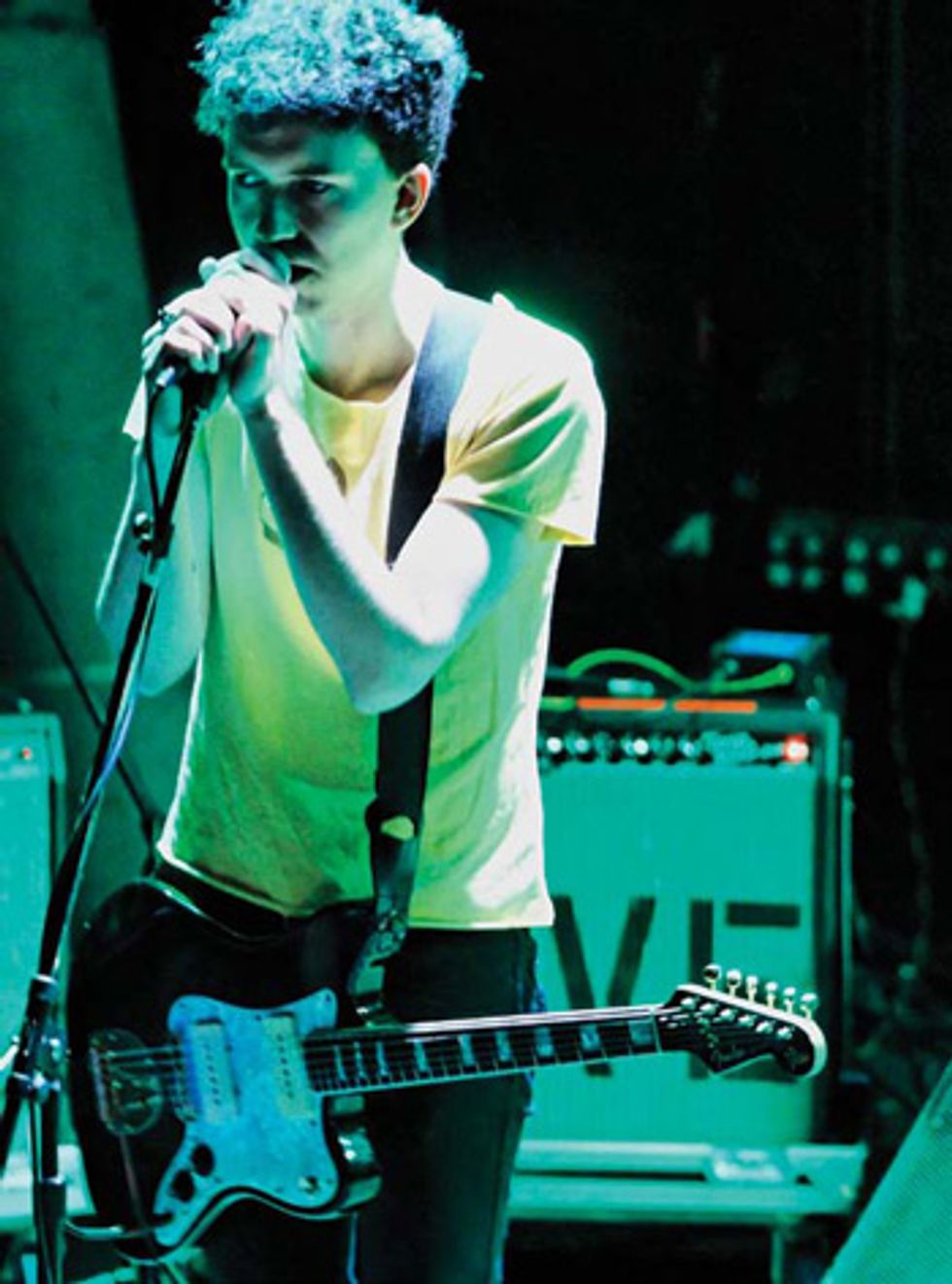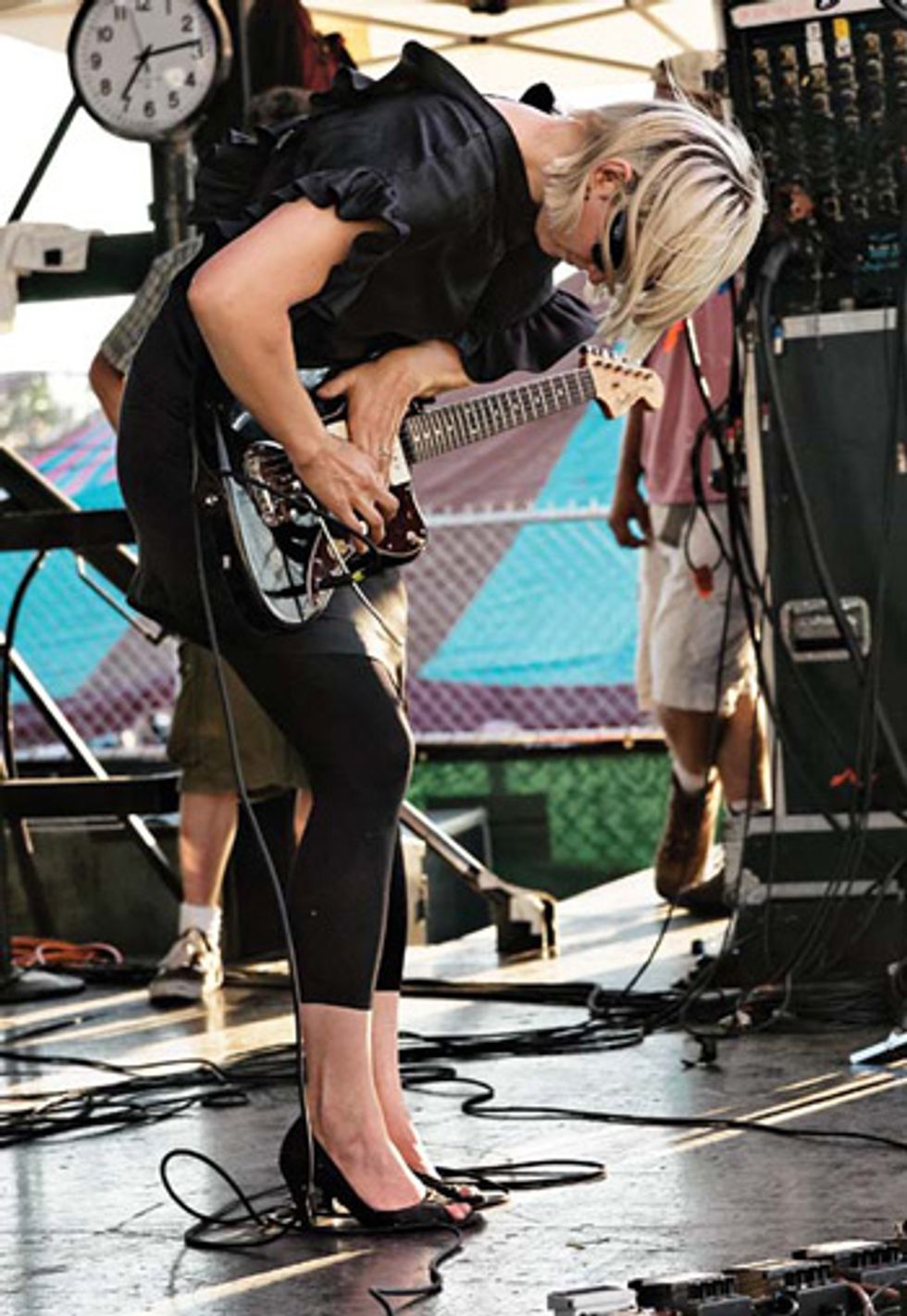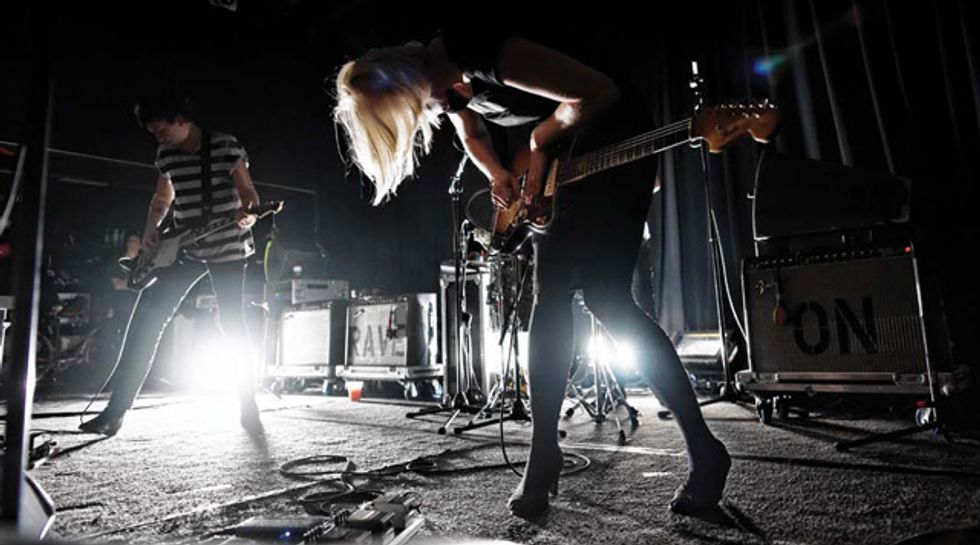Raveonettes frontman/guitarist Sune Rose Wagner wants to
seduce you, lure you in, lull you into a false sense of pop-melodic
security so strong that you don’t notice the darkness until
it’s too late. And that’s been the MO for him and his Raveonettes
counterpart, singer/bassist Sharin Foo, from their acclaimed 2002
debut, Whip It On all the way to this year’s Raven in the Grave.
“It’s like when you meet new people,” Wagner explains,
“You see them from the outside and you have a certain
notion of what they’re about, but you don’t really know what
lurks behind there. Sometimes it’s nice to make music that’s
incredibly appealing and almost sweet and very innocent
sounding, but then when you read the words you figure out
that this has nothing to do with innocence.”
 Ventures Jazzmaster at the Bowery Ballroom in New York City on March 26, 2008. The guitar has become Wagner’s favorite because “It doesn’t have all the s witches that a normal Jazzmaster has, and it feels a little bit heavier. It feels like one of those guitars that you can really travel with and nothing will break it.” |
Roots of the Rave
Wagner and Foo met in Copenhagen and were immediately drawn to each other by their shared fondness for the Everly Brothers. Foo came from a musical family and grew up surrounded by music. “My very first instrument was actually piano when I was like 7 years old,” she remembers. “That was what I started out with. My dad was a guitar player, so there were lots of guitars at home—and keyboards and pianos and 4-track and 8-track recorders. There was always that element around.”
Wagner, on the other hand, was lured to the guitar at age 15 after seeing a Dire Straits concert on television. He soon branched out, drawing inspiration from great players in a wide range of genres. “Back in the day, it was mostly a lot of blues—a lot of Robert Johnson and Muddy Waters and B.B. King and stuff like that. And then, gradually, I got into players like Jimi Hendrix. I was always a huge Randy Rhoads fan and a huge Jimmy Page fan, as well. Those were the big influences when I was growing up.”
But Wagner also developed a love of melodic songs by bands like the Jesus and Mary Chain and the Velvet Underground, and through them he discovered the classic sounds of the 1950s and early ’60s. “I think there’s a certain vibe to the music that I like,” Wagner says. “Sometimes it’s like an innocent or nostalgic feeling, but the main reason is because a lot of it is really good songwriting by really good performers—y’know, great singers, great players. It’s always been appealing to me when people can really play their instruments.”
When Foo first met Wagner, she was deeply absorbed in the Danish jazz scene. “I was in the conservatory circuit, which was more the jazz cats, and there were some incredible musicians. So I was going out a lot late at night, listening to and watching a lot of jam sessions—but not participating that much, because I’ve always been completely intimidated by jam sessions.”
But under Foo’s cool jazz-cat exterior beat the burning heart of a true rocker, and it didn’t take long for Wagner to lure her into the indie-rock scene. “It was kind of a new place,” she recalls, “but I felt very comfortable there because my heart really did belong to the Stones, the Velvet Underground, and Bob Dylan. I was finding the place that I felt very comfortable.”
From the beginning, the two found working together completely natural. Their shared enthusiasm for old-school rock ’n’ roll gave them plenty of common ground, and they soon found they also had a knack for lush vocal harmonies. “When we started out, we talked a lot about being inspired by the vocals of the Everly Brothers and how seamlessly they sing together and how extremely fluid and eloquent it is,” Foo explains. “Right when we started singing together, it was just a very organic thing. We would record stuff and say, ‘Who sang that? Was that you or me?’ Sometimes we couldn’t hear if it was a guy or a girl, and we were getting into that ... I wouldn’t say androgynous, but that weird place where you can’t tell if it’s a boy or a girl.”
A Constant Metamorphosis
Wagner and Foo’s partnership bore fruit in the form of their first EP, Whip It On, which was named Best Rock Album of the Year at the 2003 Danish Music Awards. One notable aspect of the album was that Wagner set an interesting and deceptively simple challenge— each song could have no more than three chords, and all had to be in the key of Bb minor. Their follow-up and first full-length album, Chain Gang of Love, was all in Bb major. These seemingly draconian limitations were inspired by the Dogme 95 school of filmmaking started by Danish director Lars Von Trier, and Wagner insists that the effect was anything but stifling. “It was actually really great,” he says, “because it made me incredibly inspired, and I really had to be on top of my game to make songs that still sounded interesting while not using a lot of things that people normally do.”
 |
On 2009’s In and Out of Control, Wagner and Foo mixed it up in a new way by collaborating with Danish pop star Thomas Troelsen, who co-wrote seven of the album’s 11 tracks and took on production chores. The result was a more polished effort than Lust, Lust, Lust, with two of the album's songs being featured on the popular cable show Gossip Girl.
For their latest creation, Raven in the Grave, the Raveonettes have changed the formula yet again. The ’50s-style sounds that have been so prominent on their past records have in large part been replaced with dark, ambient washes of guitar and keyboards that seem to swirl around you. “We always try to make very cinematic music, because we’re big fans of film scores and movies,” says Wagner. “A lot of the lyrical content on this album wouldn’t have fit very well had it been more of a surfy kind of vibe—it just wouldn’t have been powerful enough. So it was nice to move away from that a little bit and make something that’s more un-surfy and un-twangy.”
But Wagner remains the ever-restless artist, already anticipating— albeit humorously—another stylistic about-face. “Right after you finish the album you immediately think ‘This is a great album.’ I’m very proud of it, but now I really want to make a 100-percent surf album with eight Jazzmasters and more twang than anyone has heard before,” Wagner laughs.
Kicking the Clichés
While the Raveonettes’ music may shift gears from one album to the next, Wagner’s songwriting approach is both consistent and beautifully self-contained. Rather than piecing together riffs and parts with guitar in-hand, he prefers to do the initial writing in a more internal way. “We try to make music that is fairly simple,” he says, “and after playing guitar for so many years, I don’t really need it to write songs anymore—I know how chords work and I know what I like. I just try to come up with riffs and things in my head first, and then, if I have a riff or an idea for something, I’ll grab the guitar and make a little demo recording. But I usually sit and just think about riffs and rhythmic patterns and stuff like that, and then I pick up the guitar and figure out how to do it.”
Writing this way helps Wagner avoid some of the obvious guitar clichés that come from dependence on shapes and patterns. Another method he employs to create out-of-the-box guitar parts is to write on another instrument. “I play the piano as well, so a lot of the stuff I write on piano I transfer onto guitar. I’ll play different things on the guitar that I normally wouldn’t think of.”
When it comes to gear, Wagner and Foo have a relatively simple setup that allows them to create enormous, space-filling ambient sounds when they play live. Like many indie rockers, Wagner is a devoted fan of the quirkier Fender models. “I mainly use a 1963 Jazzmaster and a 1963 Jaguar,” he explains. “One of my favorite guitars, mostly for touring, is the 1996 Fender Jazzmaster Ventures model that they did limited editions of when they had their 50th or 40th anniversary or something. I got it from Japan on eBay, and I just bought another one. So now I can really go on the road. It just seems like a really sturdy guitar. It doesn’t have all the switches that a normal Jazzmaster has, and it feels a little bit heavier. It feels like one of those guitars that you can really travel with and nothing will break it. I’m very happy about it.”
Amp-wise, Wagner favors the tried-and-true Fender Twin Reverb, particularly the popular ’65 Twin Reverb reissue. “We’re not much for vintage amps, because it’s a little shaky touring with them sometimes. And I always really liked the ’65 reissue—it sounds wonderful, and it’s one of those amps you can get anywhere. It doesn’t matter where you play in the world, you can always order two ’65 Twin reissues, so you know you will always have your sound.”
Foo relies on a Fender Mustang. “Because it’s a short-scale, it’s good for my fingers.” She runs it into an Ampeg SVT Classic with a healthy dose of effects. While she is a multi-instrumentalist, Foo insists her favorite instrument is bass. “It’s a very natural instrument to me,” she says. “It’s that kind of grounded, heartbeat-y feel. I love that. I feel like it suits my personality better than the guitar. And also I would prefer not to be in front so much. To be a guitar player, you have to love the spotlight.”
Both Wagner and Foo rely on a few trusted pedals to recreate their atmospheric sound in concert. The secret, says Wagner, is not distortion, but chaining several reverb pedals together for massive, ambient harmonic overload. “The thing is, because we do make a lot of noise when we play live, people always think that noise comes from hooking up 10 distortion pedals,” says Wagner. “But we actually only use one distortion pedal, and it’s a Pro Co RAT—which is not even turned up a quarter of the way. Our guitars are actually not that distorted, but when you run them through three reverb pedals that are blasting, it creates so many overtones and so much craziness that you get that wall of sound—but it’s not really a distorted wall of sound. It’s just more crazy harmonics going on there.”

Sune Rose Wagner and Sharin Foo onstage with their trusted Fender Jazzmasters
and a backline of ’65 Twin Reverb reissues.
When we talked with Wagner and Foo, they were just a week away from rehearsals for the Raven in the Grave tour, and both were clearly excited to get underway. This tour, not surprisingly, will find the pair exploring yet another new lineup—one that will include two drummers. “That was actually the initial thought for the Raveonettes when we started back in 2002,” Wagner insists. “But we got into it so fast and started touring, and we got signed really early on in our career, so we just didn’t have time to make things work like that. But now we have a substantial amount of time off, and I said to Sharin, ‘Why don’t we do the two-drummer setup?’ And it would be great for this album, too, because it has very simple beats that are just looped so it’ll look great when you have two drummers play identical beats. It’ll be very powerful, like a machine that just runs through the whole thing. And also, they can both play guitar as well, if we need to change it up a little bit.”
Foo adds that the two-drummer lineup also allows them to incorporate samples without losing a live feel—a sense of immediate physicality. “When we toured on the last record, we played without tracks and samples, which was a completely new thing for us,” she recalls. “Now we want to reintroduce the electronic sound, but in a way where it’s less fixed. So we can trigger a lot with just the drums. We also like the visual, very physical feeling of two drummers.”
So when you listen to the Raveonettes—or if you’re lucky enough to catch them live—don’t say we didn’t warn you. Just behind the heady mixture of undeniable hooks, dark waves of sound, and ethereal harmonies lurk some dark and diabolical intentions. But even once you know the score, the seduction is still hard to resist. And what fun is resisting anyway?
Sune Rose Wagner's Gearbox
Guitars
1963 Fender Jazzmaster, 1963 Fender Jaguar, 1996 Fender Jazzmaster Ventures model, student model Yamaha nylon-string acoustic
Amps
Fender ’65 Twin Reverb reissues
Effects
Pro Co RAT, Boss RV-5, Boss DD-20 Giga Delay, Boss TR-2 Tremolo, Dunlop JH-OC1 Jimi Hendrix Octave Fuzz, Z.Vex Fuzz Factory
Strings and Picks
Fender Super Bullets (.010–.046), Fender medium
Miscellaneous
Mogami cables
Sharin Foo's Gearbox
Basses
1976 Fender Mustang bass
Amps
Ampeg SVT Classic
Effects
Pro Co RAT, two Boss RV-5 Digital Reverb units, Boss TU-2, T-Rex FuelTank Classic
Strings and Picks
Fender Super 7250 (.040–.100), Fender medium
Miscellaneous
Mogami cables













![Rig Rundown: Russian Circles’ Mike Sullivan [2025]](https://www.premierguitar.com/media-library/youtube.jpg?id=62303631&width=1245&height=700&quality=70&coordinates=0%2C0%2C0%2C0)
















![Rig Rundown: AFI [2025]](https://www.premierguitar.com/media-library/youtube.jpg?id=62064741&width=1245&height=700&quality=70&coordinates=0%2C0%2C0%2C0)




















 Zach loves his Sovtek Mig 60 head, which he plays through a cab he built himself at a pipe-organ shop in Denver. Every glue joint is lined with thin leather for maximum air tightness, and it’s stocked with Celestion G12M Greenback speakers.
Zach loves his Sovtek Mig 60 head, which he plays through a cab he built himself at a pipe-organ shop in Denver. Every glue joint is lined with thin leather for maximum air tightness, and it’s stocked with Celestion G12M Greenback speakers.






